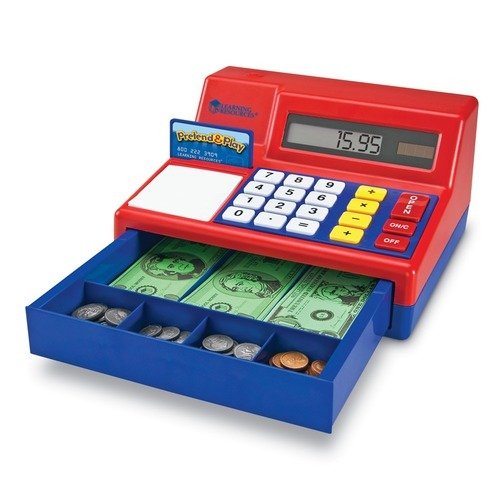Getting your child to understand and appreciate the concept of money is something that can be started at quite a young age. Most of the time, many parents are put off by the fact that children do not generally learn their numbers until they start school around age 4. However, 2-3 year old children are quite capable of understanding that money is used to purchase items, even if they don’t quite grasp monetary value. As with most new concepts, the easiest way to engage your child is still through play!
Have your child set up a shop in a room in the house. Using play money, you can start off with coins. Your child will quickly grasp the concept that you exchange a coin for an item in the shop. As they come to terms with this idea, you can progress to including paper money. Again, start simple; one paper note for one item from their shop. You could even get a cash register (like the one shared above) so that the child can get used to storing their money in one location.
As the child becomes comfortable with paper and coin money, you can introduce the idea of value. Small shopping items require one paper note, while big items require two paper notes. This can be a stumbling block for many 2-3 year olds, so be patient. They will eventually get their head around it. You could also introduce the idea of change – one paper note gets one coin of change (the idea of grocery shopping). Through this simple play activity, children can slowly come to terms with the idea of exchanging money for items.
Following on from this, you could play the sorting game with two different types of coin. At first, start with distinctly colored coins, and ask the child to separate them into their respective piles. Another encouraging tactic is to take your child shopping with you. At first they can observe you paying for your grocery shopping with your money, just like you do in their shop. If the child shows an understanding of this concept, you can even encourage them to pay for their own item. For example, if they wish to buy an apple, let them hand money over to the shopkeeper for their apple and receive their change.
These basic skills all contribute towards a solid understanding of the concept of money, and will make it much easier to establish a healthy and responsible attitude towards money as they grow up. Children who learn about money at a young age are far more open to the idea of saving money as they grow up – a concept that is unfortunately rare amongst young adults these days. By starting them early, you are helping to establish a responsible attitude towards money in later years.

